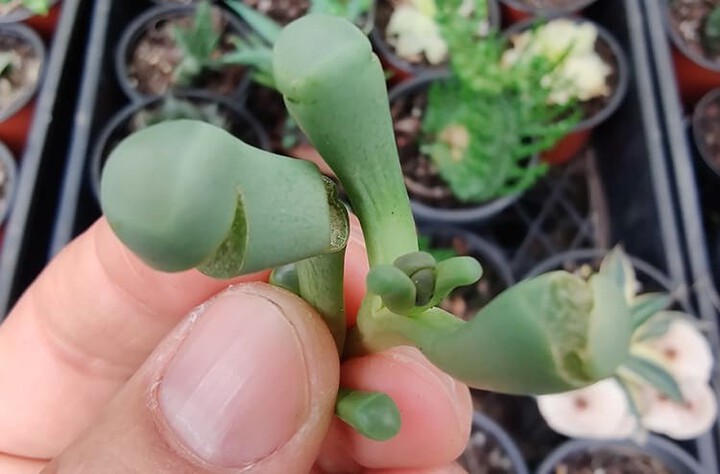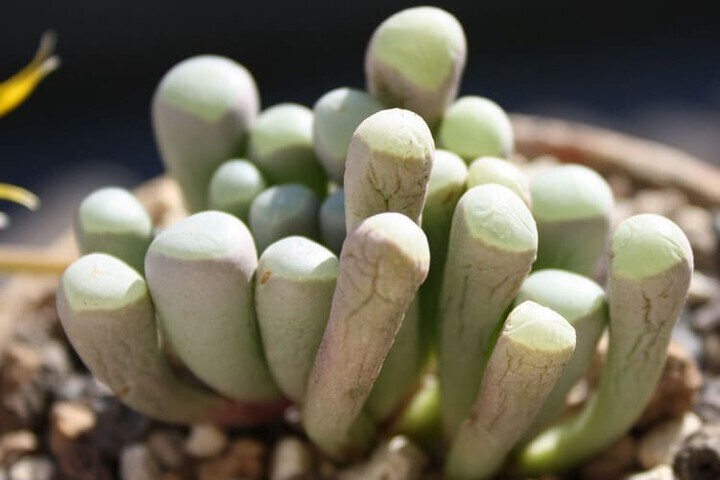If you love your baby toes succulent so much that you want more, there are two options for propagation.
The Fenestraria is known as being very slow-growing and the seeds are one of the hardest to germinate, making them not ideal for this type of purpose.
If you do want to attempt to start from a seed, you need well-draining soil and warm weather to grow them outside.

The best approach for growing new plants is to use offsets which will grow directly out of the main plant.
Use a sharp and sterile knife to make the cut, or if there’s a small start growing at the base of the plant, you can take it from here.
Give them a couple of days to dry before you replant them for the best results.
Growing Tips For A Healthy Baby Toes Succulent
Owning a baby toes succulent is a treat, as they always give you something adorable to look at, but don’t require a lot of hard work to keep them that way.
Here are some tips to keep in mind if you own a Fenestraria yourself and want to ensure it stays happy and healthy for years to come:
Keep an eye out for leaves turning yellow with this plant, which usually means the plant has been overwatered and needs time to dry out.
There’s no need to worry about pests and disease with a baby toes succulent so you won’t require any products to keep them away.
Keep your pets and small children away from this plant and other succulents you have as they can be toxic to animals when eaten.
Succulents are prone to root rot so if you suspect something is wrong, remove it from the pot and dry the roots out before rehoming it.
During summer, you can usually leave this succulent on its own without much water. As a subtropical species, it survives in extreme weather conditions and will do well when it’s hot.
Your baby toes can be kept on its own or added to a landscaped garden outside or in a container with other succulents if you have this type of setup.
When the temperature drops, move your baby toes succulent to a windowsill that gets a lot of bright light to keep it warm and away from harsh outdoor conditions.
A Cute But Hardy Succulent

There are few plants out there that combine the adorable looks of the baby toes succulent with the absolute hardiness of it, and with these two together it’s no wonder this is one of the most popular succulents out there.
The Fenestraria Rhopalophylla is an ideal choice for beginner and expert gardeners alike, and especially those who are fond of succulents.
Whether you choose to grow yours indoors where you can control the conditions to its liking, or let it flourish outdoors and with the extreme heat and brightness that it prefers, you’ll find that they’re an easy plant to grow.
If you’ve been looking for a new succulent to plant or want to get your kids involved with your love for plants, there’s no better way to start than with a baby toes.
This endearing and hardy plant will be around for years and let you enjoy all of the best parts of owning a succulent without any of the hard work that other plants require.
Related Questions
Baby toes succulents are just one of many wonderful plants in the succulent family, and one of the most adorable plants without question.
If you want to learn more about succulents and how to take care of these unique plants at home, we’ve answered some FAQs that can give you a push in the right direction.
Can You Touch Succulents?
Although their leaves look plump and inviting to touch, you should avoid touching a succulent as much as possible.
The most delicate part of this plant is it leaves and even if they look tougher than other plants, they can still become damaged when you touch them.
The roots of a succulent are hardy so even if all of the leaves fall off, they should be able to grow new ones.
Can You Crowd Succulents?
If you plan on adding baby toes succulent to another garden, make sure you’ve given them enough space of their own to grow.
Although succulents do well grouped with others, you increase the chance of mold and insect infestations when they’re overcrowded, as well as reduce their ability to get food and water, so don’t put them too close together.
Do Succulents Need Direct Sunlight?
There are many types of succulents that each require different things from the sun, but in general, you should try to keep them out of direct sunlight when they’re young.
A freshly planted or rehomed succulent will become scorched in direct sunlight so it’s better to introduce them to these conditions slowly with just a few hours a day at first.